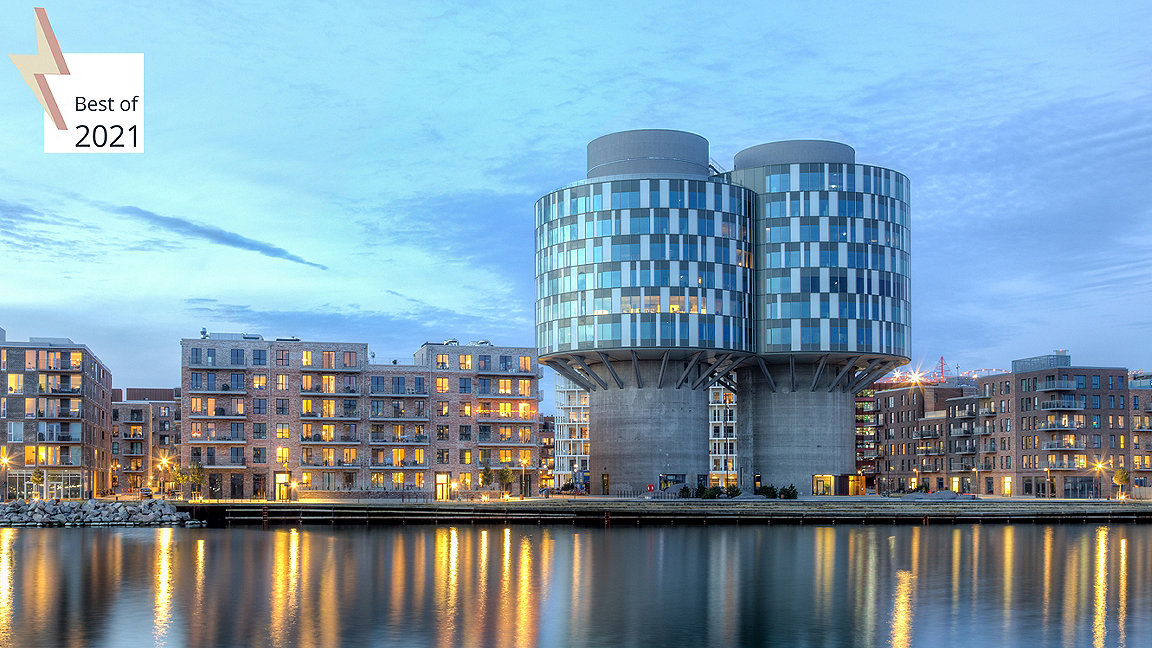
Evening view of the Portland Towers, two silos converted into office buidings in the Nordhavn district of Copenhagen, Denmark
Since their extension in 2013 to include conversion of offices to residential, permitted development rights (PDRs) for conversion of commercial to residential uses have come under persistent scrutiny.
However, despite sustained criticism, in particular of office conversions, it seems that PDRs remain high on the list of government responses to the housing crisis. To get a balanced view of their impact, this article will explore the benefits of extending PDRs – and their negative impacts.
John East: PDRs save cost and time
Even a straightforward planning application can take several months to be processed to the point of a decision, and longer if there are complexities, so this process can be costly and time-consuming for developers. As PDRs allow them to bypass the usual planning process, they save on borrowing costs and time, even after the fee per home for exercising the rights is paid.
A case study by building and project consultancy Jonathan Cornes Associates has looked at the pros and cons of converting commercial premises into homes compared to new build, and concluded that the former can be cheaper in many instances.
As an example, the costs of redeveloping a brownfield site can escalate where contamination has to be remediated or additional works have to be undertaken to stabilise the ground. With PDR conversions, however, the building superstructure already exists and as the loading requirements for an office are greater than those of an apartment, they can easily and cost-effectively be redeveloped as residencies.
Not having to dig foundations and construct a new-build structure upwards from the ground will also save the developer considerable time. A BCIS study calculated that construction of a new-build block of flats with a contract value of £450,000 takes 38 weeks, and a project with a contract value of £800,000 takes 44 weeks. Two comparable conversion schemes take 22 weeks and 39 weeks respectively, enabling a saving of between 10% and 40% in the time needed on site.
BCIS also observed that this correlates with savings in the design period, making properties available to clients much sooner than new builds.
Hannah Keilloh: Developers save at public expense
While it could be argued that permitted development is potentially a less expensive and quicker option for housing developers, there are drawbacks that cannot be overlooked.
Commercial-to-residential conversions using PDRs prevent local authorities from ensuring contributions to necessary social and physical infrastructure, as the section 106 agreements that would otherwise be made through a planning application are sidestepped.
Such agreements play a vital role in ensuring that the impact of having more homes in an area is appropriately mitigated, and that supporting infrastructure such as green space, community and healthcare facilities, roads and public transport is in place.
A 2018 RICS study of the impacts of extended PDRs across five local authorities estimated that those local authorities lost a combined total of £10.8m in section 106 funds over a four-year period as a result of the rights being exercised.
These local authorities lost a further £4.1m in reduced application fees. The study's authors described office-to-residential permitted development as a 'fiscal giveaway from the state to private-sector real-estate interests'. There is a significant risk that ongoing extensions to the use of PDRs will result in many homes being created in areas without the necessary infrastructure and facilities to support them.
In addition, PDRs do not enable local authorities to ensure adequate contributions are made towards much-needed low-cost housing. Section 106 is currently a major mechanism for such provision, particularly homes for rent. In 2018/19, 49% of all affordable homes completed were funded through section 106 agreements.
Research by the national charity for homeless people Crisis and the National Housing Federation shows that 100,000 homes for social rent need to be built every year for the next fifteen years across Great Britain (90,000 in England) to meet demand.
In 2018, housing charity Shelter estimated that urban authorities had missed out on more than 10,000 affordable homes between 2015/16 and 2017/18 alone because local authorities cannot enter into section 106 agreements with developers and require a supply of any on-site or off site affordable housing contributions under the PDR system.
Without a supply of affordable housing, residents can remain on local authority waiting lists for longer while living in temporary accommodation. This temporary accommodation has often been created through previous conversions using PDRs. The uncertainty of the situation frequently combined with poor living conditions can impact physically and mentally on individuals and families. Research has shown that children who live in temporary accommodation for more than a year are three times more likely to develop a mental health condition.
So we must ask: what price are we prepared to pay for PDRs?
'Commercial-to-residential conversions using PDRs prevent local authorities from ensuring contributions to necessary social and physical infrastructure, as section 106 agreements are sidestepped'

JE: Safeguards ensure quality of homes
PDRs should not lead to substandard homes. From September 2020, homes created through PDRs in England must meet the nationally described space standards: that is, 37m2 of floorspace for a one-bedroom flat with a shower room, or 39m2 if it has a bathroom.
PDRs are still constrained by exclusions and limitations, such as special conditions on a property or local area, on design and on materials. The right to build upwards, for example, only applies to eligible dwellings built between 1948 and 2018. In addition to qualify, existing blocks of flats must also be detached and three storeys or more above ground level.
Any development or change of use is subject to prior approval as well, meaning builders still need to advise the local authority before work starts. It has the right to refuse, and also charges a fee for this process. Furthermore, neighbours will still be consulted on the conversion.
As apartments created by conversion can be sold or let, developers will be required to design and specify them to meet the needs of the target market, both inside the flats themselves and throughout the communal areas. This includes the provision of natural light through suitable windows in each habitable room. The actual specification will be individual to each development and driven by buyer or tenant demand, and what else is available in the area in that price range.
As agents who regularly advise clients on desired and appropriate specification and finish in new developments, we at Kinleigh Folkard & Hayward (KFH) recommend that any PDR conversion provides the same level of specification as if it were a new build. For instance, it should incorporate smart technology as appropriate, this being popular with buyers and tenants alike.
Valuers will also be assessing these homes for mortgage purposes, and, like new-build schemes, there are no specific regulations on the finish that developers should provide; however, they will need to comply with lenders' requirements. Any conversions using PDRs will also need to comply with the Building Regulations.
Looking ahead, under changes to planning proposed in the Planning for the future white paper in August of 2020, communities could be involved in discussions to shape design codes for their area, with the intention that these would also cover PDR conversions.
HK: Statutory safeguards are insufficient
While expanded use of PDRs may ensure a greater quantity of new homes, we at the Chartered Institute of Housing (CIH) firmly believe that the rights do not, and will not, provide the quality of homes that we need.
Research funded by the Ministry of Housing, Communities & Local Government in 2020 found that such conversions create 'worse-quality residential environments'.
Similarly, Nick Raynsford's 2018 review of planning concluded that government PDR policy 'has led directly to the creation of slum housing'. It went on to say: 'Such slums will require immense public investment, either to refurbish them to a proper standard or to demolish them. Morally, economically and environmentally it is a failed policy.'
Since the publication of this research, the government has brought forward legislation to ensure that conversions using PDRs must meet the nationally described space standards and provide for adequate natural light. CIH welcomes these moves, but we must be clear that these are basic minimums, not standards for quality.
Investigations by the Guardian have highlighted how the substandard accommodation created through PDRs do not meet the specialist needs of some of the people who live in them, in particular families who are homeless.
The continuing push to expand PDRs runs the risk of more people being forced to live in inadequate and inappropriate housing. We must also seriously question how disabled and older residents might live well in these conversions.
The Housing Made for Everyone coalition, of which CIH is a founding member, is calling for all new homes to be built to higher accessibility standards as a default, and healthy homes legislation to ensure that all new homes are of decent quality.
While the prior approval process does provide some checks and balances for any conversion under PDRs, it cannot provide the rigorous scrutiny required for new dwellings that the planning application process would afford.
The policy aspirations of a community in a local or neighbourhood plan do not have a clear legal weight in determining PDR decisions. Many important issues cannot be considered adequately, if at all, through prior approval, including health and well-being, design, location, and carbon emissions.
JE: PDRs support the 20-minute neighbourhood
The 20-minute neighbourhood is the premise that people should have everyday amenities within a walk or cycle of no longer than this time. Lockdowns and the growing green movement have been adding weight to the argument for such neighbourhoods.
Many places within inner London are already 20-minute neighbourhoods, and this is what makes them so desirable to buyers and tenants – and as a result, to investors. For empty commercial premises in town centres further out, this concept can be taken up with a number of benefits.
The 20-minute neighbourhood can foster a strong sense of community and connection to a place, as residents socialise locally, support local businesses, and enjoy local parks. High streets will be rejuvenated as they adapt to the increased demand from local residents. There could potentially be less reliance on vehicles, which in turn could improve health thanks to better air quality.
Before the pandemic, connectivity between places and transport access to major employment hubs was a key factor in some locations attracting higher volumes of home seekers. Anecdotally, the pandemic has fostered community spirit and more focus has bring put towards helping residents and businesses in their neighbourhoods.
Local authorities and Transport for London have provided new temporary cycle lanes and wider pavements has also helped to create a better feeling of space, and these may even become permanent in some cases given reductions in motor vehicle traffic.
Among these communities there are well located and perfectly solid buildings that are, in some cases, a little tired and in need of regeneration. However, with the promotion of home working, many of these buildings are now deemed an unnecessary expense for some companies that no longer wish to maintain or renovate additional office space.
With government targets for providing new housing that supports residents' health, optimising such redundant space through PDRs will help to protect the pressured boundaries of the green belt, and provide new homes in a swifter and more cost-effective way than most new-build schemes.
Using potentially unwanted town-centre commercial buildings that are suitable for conversion into residential uses in this way will be key to improving the appearance of the local environment, increasing economic resilience and belonging for communities, and improving the quality of life for residents.
'Using unwanted town-centre commercial buildings that are suitable for conversion into residential uses will be key to improving the appearance of the local environment, increasing economic resilience and belonging for communities, and improving the quality of life for residents'

HK: PDRs do not guarantee 20-minute neighbourhood
The 20-minute neighbourhood is a tangible way to underpin the development of sustainable communities and something that CIH supports. The homes and neighbourhoods in which we live are fundamental for our health and well-being, and this has rarely more been acutely felt than during the pandemic.
However, we consider PDRs are at odds with creating such neighbourhoods. While such deregulation could mean homes are created in town-centre locations where there are also many facilities such as shops, theatres and restaurants, there are no checks in place through the prior approval process to ensure that the necessary physical and social infrastructure is in place before conversion.
Conversions have often occurred in entirely unsuitable locations as well – a far cry from a 20-minute neighbourhood, and there is nothing to prevent this. For example, conversions such as Connect House, in Mitcham, London, have taken place on active industrial estates that are not within walking distance of schools or shops and that even lack pavements or safe places for children to play.
You would currently be hard pushed to find many town and city centres that have the adequate educational or open space provision necessary to support a large increase in families within easy walking distance. Without section 106 contributions to ensure the infrastructure and facilities are put in place, many new residents may find themselves having to travel considerable distances to take their children to school or access green space or play areas.
Local authorities are best placed, through consultation with the communities they represent, to plan and set out shared, strategic visions for their high streets, town centres and indeed 20-minute neighbourhoods. Unregulated, piecemeal conversion of commercial units into homes using PDRs could undermine this.
In February, leaders from across the property, retail, leisure, hospitality and planning sectors composed a joint letter to housing secretary of state Robert Jenrick, stating: 'Putting ground-floor housing in a random and uncontrolled manner on high streets does not draw footfall, does not support new businesses, reduces the potential for business growth and will undermine the viability of existing retail, cultural and commercial activities on the high street and remove convenience stores from local neighbourhoods.
'This will create a vicious circle whereby the reduced viability of the remaining commercial uses in turn threatens their existence and incentivises their conversion to residential.'
Expansion of PDRs and further limiting of article 4 directions are preventing local authorities from ringfencing valuable alternative town-centre uses such as leisure, entertainment, tourism, culture, offices and retail and making effective planning and placemaking – which are needed to create 20-minute neighbourhoods – impossible.
Hannah Keilloh is a policy and practice officer at the Chartered Institute for Housing
Contact Hannah: Email
Have your say
We would love to hear your opinions on this topic. Please email Property Journal editor Brian Ward if you would like your feedback to be considered for a future article.
